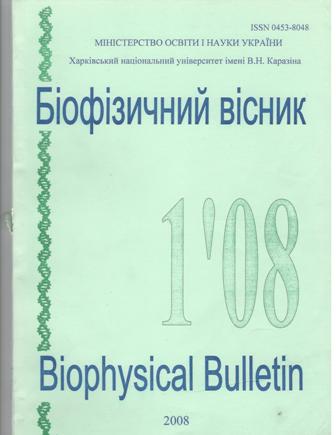Теоретичний аналіз ефективності лінійного і двоступеневого режимів заморожування для кріоконсервування ембріонів ссавців
Анотація
Метою роботи є теоретичне обґрунтування доцільності застосування для кріоконсервування ембріонів ссавців нелінійних двоступеневих режимів заморожування. На основі порівняння теоретичної залежності переохолодження внутрішньоклітинного розчину від часу (або температури) при лінійних і двоступеневих режимах заморожування встановлені і пояснені переваги останнього для кріоконсервування ембріонів ссавців. Теоретична оцінка оптимальної по двухфакторной теорії кріоушкоджень швидкості охолодження дія двоклітинного ембріонів миші збігається з експериментальними даними.
КЛЮЧЕВЫЕ СЛОВА: криоконсервирование, скорость охлаждения, быстрое двухступенчатое замораживание, эмбрион млекопитающего
Завантаження
Посилання
2. Е. А. Гордиенко, Н.С. Пушкарь. Физические основы низкотемпературного консервирования клеточных суспензий. Киев: Наук, думка, 1994.- 143с.
3. Mazur P. Cryobiology: the freezing of biological objecls//Science.-1970.-168. N3934/-p.939-949.
4. Котык А., Яначек К. Мембранный транспорт -М;Мир.-1980.-341с.
5. Wood M.J., Farrant J. Preservation mouse embryos by two-step frrezing//Cryobiology.-1980.-17-p. 178-180.
Автори, які публікуються у цьому журналі, погоджуються з наступними умовами:
- Автори залишають за собою право на авторство своєї роботи та передають журналу право першої публікації цієї роботи на умовах ліцензії Creative Commons Attribution License, котра дозволяє іншим особам вільно розповсюджувати опубліковану роботу з обов'язковим посиланням на авторів оригінальної роботи та першу публікацію роботи у цьому журналі.
- Автори мають право укладати самостійні додаткові угоди щодо неексклюзивного розповсюдження роботи у тому вигляді, в якому вона була опублікована цим журналом (наприклад, розміщувати роботу в електронному сховищі установи або публікувати у складі монографії), за умови збереження посилання на першу публікацію роботи у цьому журналі.
- Політика журналу дозволяє і заохочує розміщення авторами в мережі Інтернет (наприклад, у сховищах установ або на особистих веб-сайтах) рукопису роботи, як до подання цього рукопису до редакції, так і під час його редакційного опрацювання, оскільки це сприяє виникненню продуктивної наукової дискусії та позитивно позначається на оперативності та динаміці цитування опублікованої роботи (див. The Effect of Open Access).





